In 2018/19, KRC Genk academy product, Dante Vanzeir (175cm/5’9”, 68kg/149.9lbs), who primarily plays as a centre-forward but has also been sporadically used as a right-winger during his young career, scored 13 goals and made two assists during a loan spell at Beerschot V.A in Belgium’s second-tier – Belgian First Division B. He played a significant role in Beerschot competing at the top of the division and only narrowly missing out on promotion that term, ending the campaign as the joint-second-highest goalscorer in Belgium’s second-tier.
The following campaign – 2019/20 – Vanzeir joined KV Mechelen, who’d been promoted to the top-flight over Beerschot in 2018/19. Vanzeir didn’t enjoy such a good time in First Division A that season, as he ended a campaign in which he struggled for consistent first XI minutes with just three goals to his name in 752 league minutes. With his capability at First Division A level looking questionable following that season with Mechelen, Vanzeir ultimately left his parent club, who regularly compete at the top of First Division A and feature in continental competition, joining second-tier Royale Union Saint Gilloise permanently. His contract with USG runs until the end of June 2024.
Vanzeir’s return to Belgium’s second-tier last season was successful, as he helped USG to earn promotion to the top-flight for the first time in 48 years, ending the First Division B season as the top goalscorer and with the most direct goal involvements (19 goals and eight assists – 27 goal involvements). This season, the 23-year-old looks set to leave former club Genk with some regrets about letting him depart when they did, as he’s got his First Division A campaign off to a flying start, bagging five goals and three assists in his first seven league games.
The 23-year-old is performing at such a high standard that Belgium national team manager Roberto Martínez recently declared: “He will receive an opportunity to appear in the [Belgium national team] if he continues to perform at the same level”, but what is he currently doing to perform at such a high level?
Our tactical analysis and scout report provides some in-depth analysis of the 23-year-old Belgian’s all-around game. We’ll highlight why Martínez has indicated that Vanzeir may well deserve an opportunity to play alongside the likes of EPL side Manchester City’s Kevin De Bruyne and La Liga titan Real Madrid’s Eden Hazard in the world’s #1 ranked national side, per the FIFA World Rankings, while highlighting his role within Felice Mazzù’s USG tactics and providing a deep dive into what we’ve identified as some of the key strengths and potential areas of improvement within his game.
Blindside runs
Vanzeir ended the 2020/21 campaign with 19 goals from 12.53 xG, per Wyscout. This was the third-highest xG and joint-most goals scored of any striker in the division, with four of those goals coming from penalties. Vanzeir received a lot of high-quality goalscoring opportunities last season and took a high number of shots – an average of 2.48 per 90, the seventh-most of any striker to have played at least 600 minutes in First Division B—hitting the target with a large number of them—53.85%, also the seventh-most of any striker to have played at least 600 First Division B minutes. The attacker ended the season with by far the league’s best conversion rate for a striker to have played at least 600 minutes – 36.538%.
Off the bat, we can see that while the USG man rightfully ranked very highly in terms of goals in Belgium’s second-tier last season by taking a lot of the high-quality chances presented to him, he did end the campaign with a ridiculously high conversion rate which any top striker in Europe would drool over. This can probably be attributed to a number of factors, including his relative high quality for the league.
So far this season, Vanzeir has actually managed to take even more shots on average (2.73 per 90) while he’s shown his impressive shooting technique and ability to routinely hit the target with those shots, which is evident in his stellar 65% shot accuracy – an improvement on the already impressive 55.68% shot accuracy he ended last term with. This leaves Vanzeir with a shot conversion rate of 25% for the 2021/22 First Division A campaign so far and while that pales in comparison to last season’s outlier showing, it’s still a fantastic conversion rate, especially at a higher level, which highlights the attacker’s efficiency in front of goal.
In summary, Vanzeir has been really efficient in front of goal with USG. His reliability at USG has seen him hit the target with most of his shots and convert a relatively high number of them. USG bank on Vanzeir’s goalscoring quality quite a bit and in their system, many of their shots end up going through him. The attacker has rewarded his team’s faith through his high-quality finishing.
Vanzeir doesn’t regularly score the spectacular. He doesn’t shoot from range a lot, nor does he dribble through defences much. He engages in a relatively low number of dribbles for a striker and while, as stated previously, he takes a lot of shots, don’t take this to mean he shoots on sight, as this isn’t the case.
Vanzeir is a typical penalty box striker. A lot of his most effective moments on the pitch are actually quite subtle and probably go under the radar, in general. In terms of the goals he scores, a lot of them see him simply finish off a move with one/two touches in a way that doesn’t stand out much. He’s the kind of striker someone might say generally just manages to be in the right place. However, much of Vanzeir’s genius lies in his off-the-ball movement.
In our first section of analysis, we’ll highlight Vanzeir’s mastery of the art of the blindside run. Of his five league goals this season, four have seen him essentially ‘ghost’ into play at the back post behind a defender where he can finish a move off.
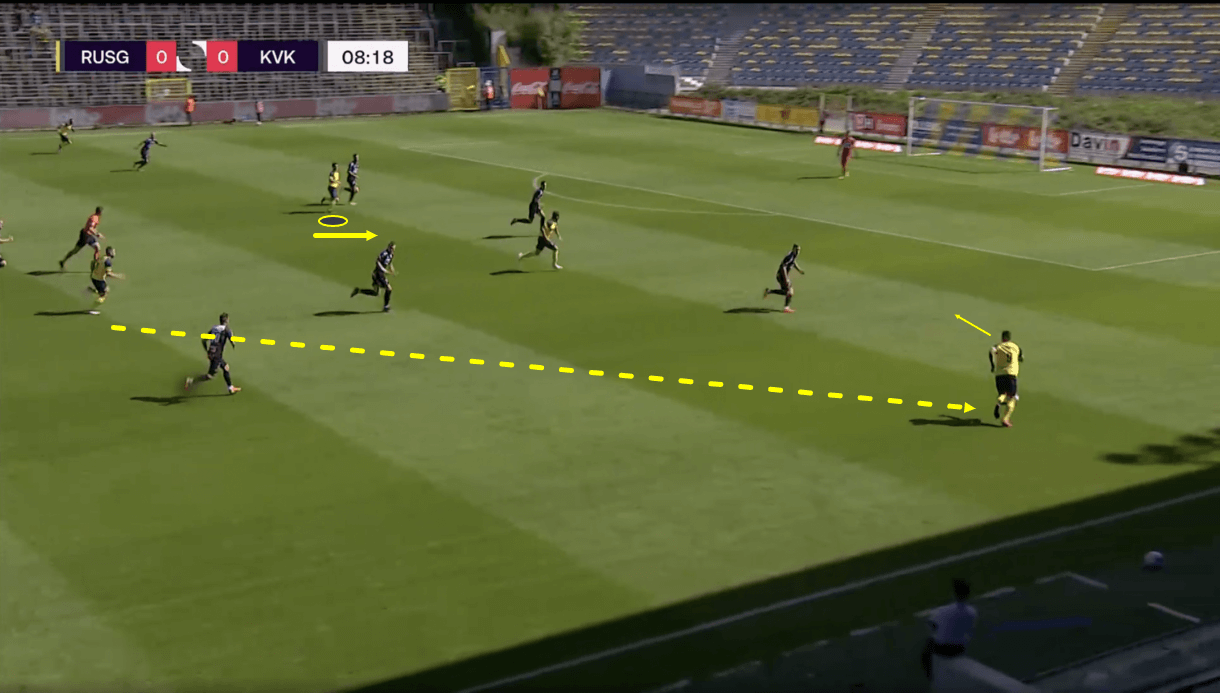
In figure 1, Vanzeir is highlighted in the left-forward position that he frequently occupies alongside Deniz Undav in USG’s typical 3-5-2 shape. Vanzeir and Undav rotate quite frequently in their striker positions, however, so you’ll also often see Vanzeir in the right forward position. Regardless of which forward position he occupies, Vanzeir generally operates the same way. He isn’t generally heavily involved in build-up, preferring to look for space to exploit within the final third – preferably the box, either at the back post or in behind the defensive line.
Just before this image, USG’s right wing-back received the ball in space on the right-wing and as he begins to move forward, he gets his head up to assess his options in the final third, with Vanzeir making a run at the far post and Undav doing the same at the front post. Vanzeir initially begins moving in front of the nearest centre-back, potentially looking to exploit space being created between the defenders by Undav’s front post run, but as play moves on, we see the striker change course and go with his preferred run to the back post – demonstrating how a blindside run should be made, and what the benefits of it are.
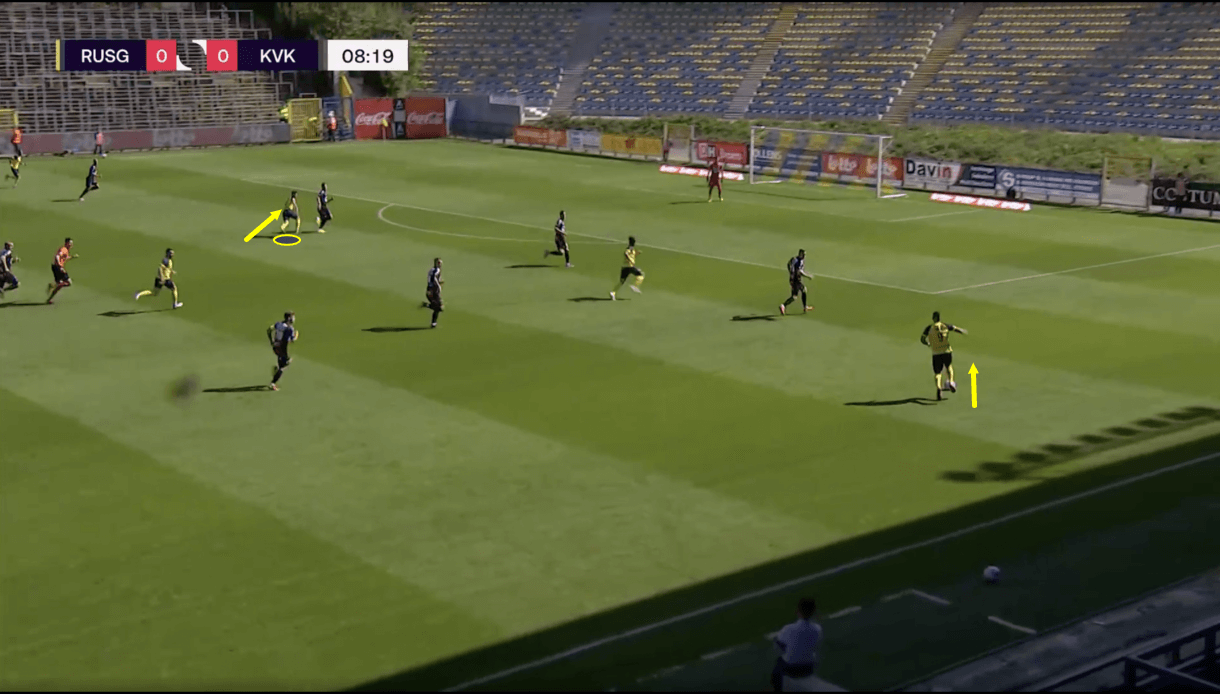
Moving into figure 2, we see how Vanzeir changed course to target the far post, while the right wing-back continued moving towards the box to get into a better crossing/passing position. As play moves on from here, we see Vanzeir momentarily move towards the front of the centre-back once more before once again quickly changing course and attacking the back post.
The reason Vanzeir ‘zig-zagged’ his run like this was to influence the defender’s movement. When he moved towards the front, the defender reacted and moved with him. This opened up even more space for the attacker to target on the defender’s blindside towards the back post.
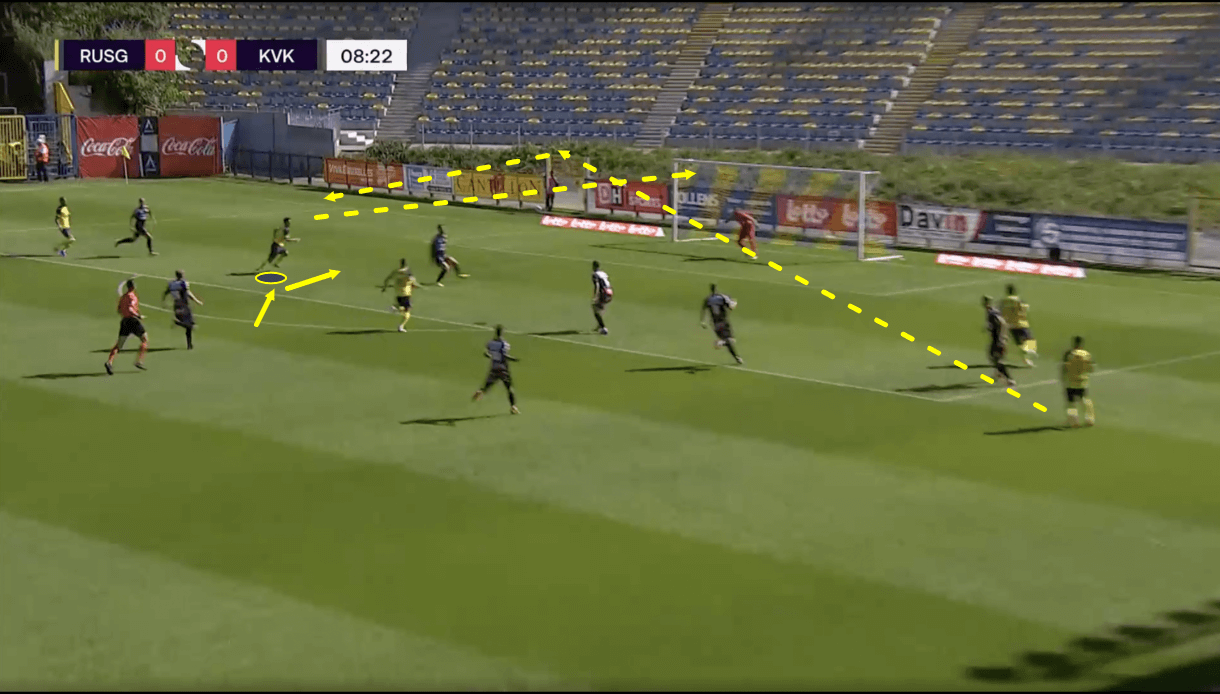
In figure 3, we see that a few seconds later, the right wing-back released his cross, targeting Vanzeir at the far side of the box. The attacker was in lots of space that he created thanks to his movement, including the intelligent use of a blindside run that made him more difficult for the centre-back to defend against. Vanzeir finished this chance well with his head – demonstrating another solid element of his game – good heading ability.
The 23-year-old scored two headed goals last season and has already bagged one this term. While he’s not the biggest striker, his intelligent movement helps him to create heading opportunities like this one where he enjoys enough space to get up for the ball and shoot effectively unchallenged. When challenged by a centre-back – who will always outmatch Vanzeir for size – the Belgian will typically lose the aerial duel, he’s not a target man, by any means. However, he’s able to create free heading opportunities like this one which he’s more than capable of finishing.
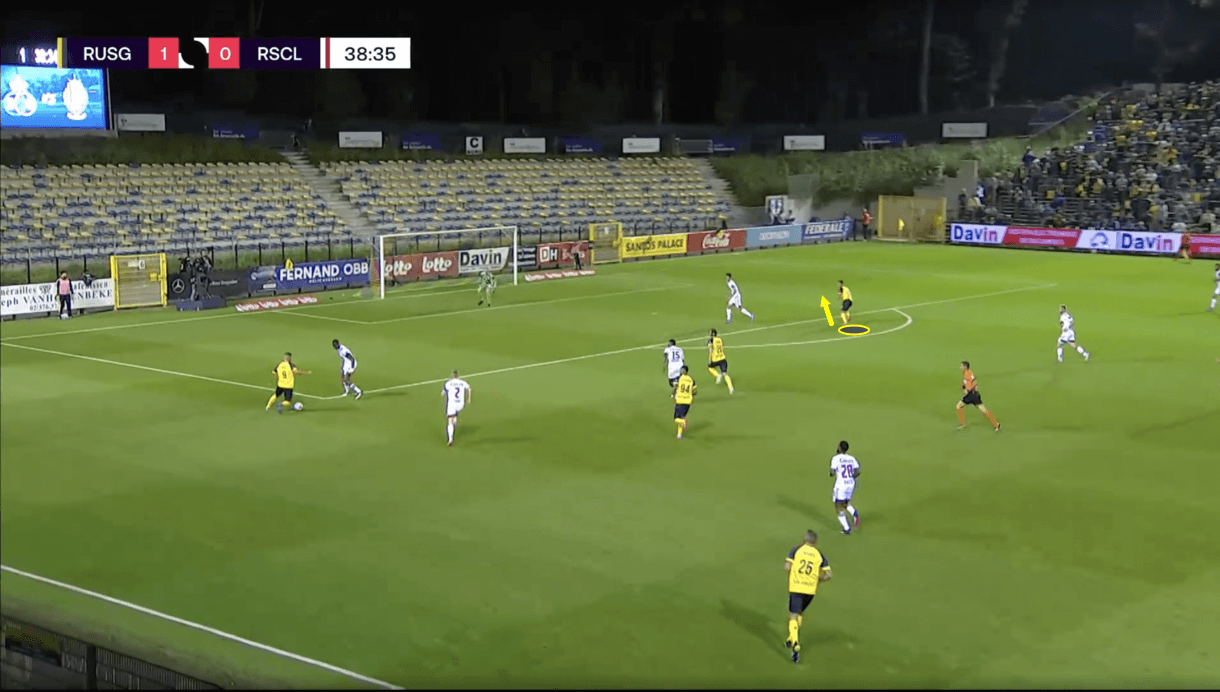
Another example of Vanzeir pulling away behind the defender towards the back post is seen in figure 4. This image is from USG’s dominant 4-0 win over Standard Liège last month in which Vanzeir scored a hat-trick of back post finishes. Just before this image, Vanzeir’s partner in attack, Undav, picked up the ball on the left-wing and started dribbling towards the box. Meanwhile, Vanzeir had just one goal in mind – find space at the back post for Undav to look for once in a better crossing position.
As the opposition’s nearest centre-back began moving centrally while his centre-back partner was pulled towards Undav, Vanzeir began to pull off his shoulder and move away into space at the back post. This move highlights the connection between Undav and Vanzeir, and why they operate so well together in a two-man striker partnership.
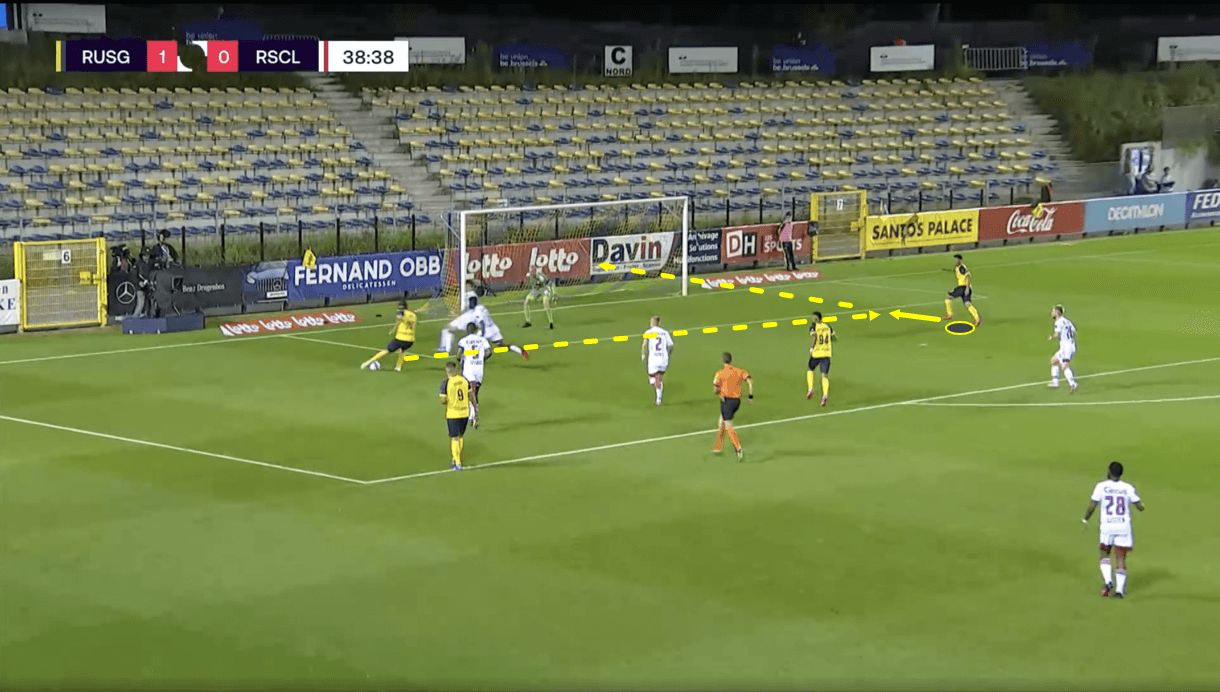
As play moves on into figure 5, we see that Undav unsettled the opposition defence by beating the right centre-back with his dribble and forcing the left centre-back to move across the box towards him. This left Vanzeir in way too much space at the back post, and as play moves on from here, we see Undav drill the ball across goal, knowing his partner was there in his usual position to finish the move off in a nonchalant manner.
It’s the accumulation of chances like this and Vanzeir’s constant demonstration of good, intelligent off the ball movement to create these chances that leads to his high number of goal contributions and high conversion rate. He doesn’t need to touch the ball before finishing to create space for himself and increase his likelihood of finishing the move successfully, as the back post, blindside run demonstrates.
Targeting space in behind
To reiterate, four of Vanzeir’s five league goals this term have come via blindside runs to the back post. His fifth came via as a result of a run in behind a relatively high backline, which is the other way in which the 23-year-old forward typically pops up to score goals.
Again, this type of goal won’t generally require Vanzeir to take more than one or two touches before shooting and doesn’t generally see him get much involved with the build-up. This type of goal is another example where Vanzeir’s off the ball movement – an area in which he’s really strong – plays a starring role.
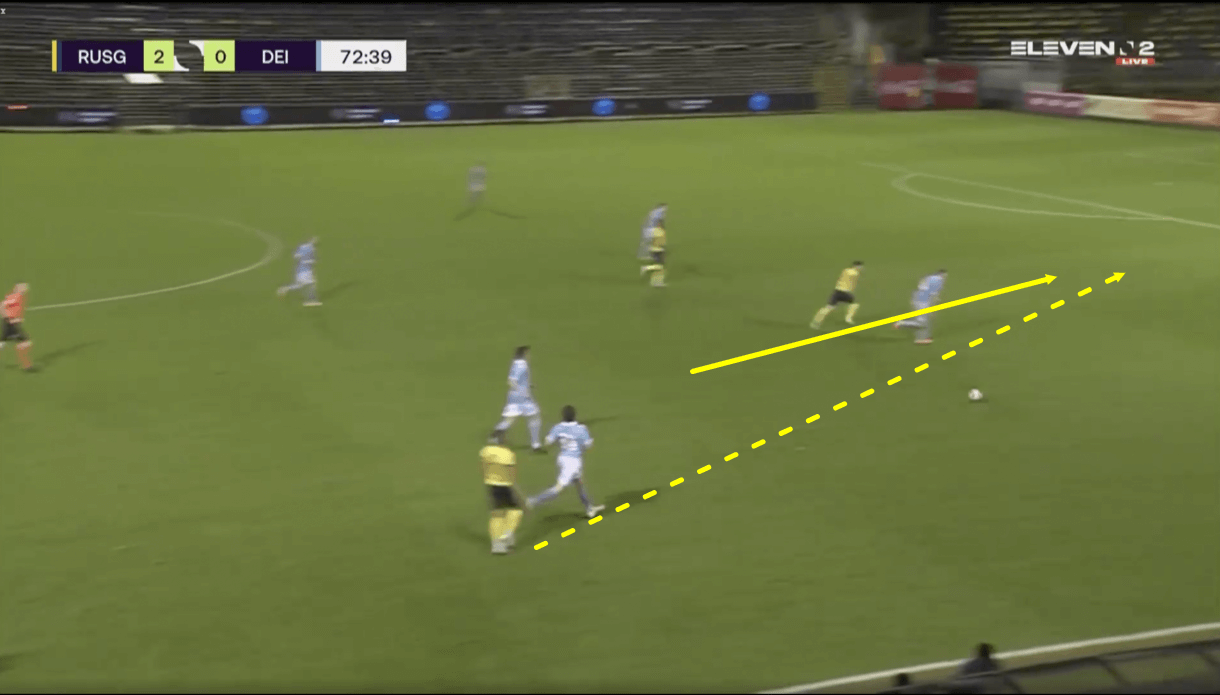
We see an example of Vanzeir running in behind the opposition’s backline in figure 6. Here, with Vanzeir playing as the right forward, USG’s right wing-back sent a drilled through ball into the 23-year-old’s running path. Just before this image, Vanzeir started his run a few feet before he was set to be in line with the last defender so as to remain onside while giving himself a chance to build up speed and gain an advantage over the defender who’d be starting his run from a standing position, while turning.
This is an example of Vanzeir demonstrating intelligent decision-making in terms of his movement and when the through ball is eventually played, releasing the attacker in behind the backline, he’s reaching full speed, almost in line with the backline and enjoying a head start. All of this, combined with the fact that he is a fast striker in general who most defenders will likely find it difficult to beat in a foot race 1v1 from a starting position anyway, helps Vanzeir to get onto the end of this through ball and within a couple of touches, progress into a good shooting position 1v1 with the opposition ‘keeper inside the penalty box, which he finishes well.
Vanzeir’s effectiveness in this type of situation is one of a few reasons why he is so effective in offensive transitions, and why I believe he may ultimately be best-suited to a heavy counter-attacking system. The attacker is a really useful outlet in these situations because of his intelligent runs and his pace, both of which can combine to exploit high lines very effectively. Additionally, we know Vanzeir is a good finisher. He’s at his best inside the penalty box while he doesn’t like to get too involved in the build-up and being the intended receiver of a ball in behind the opposition backline on a counter-attack plays to these strengths and preferences of his.
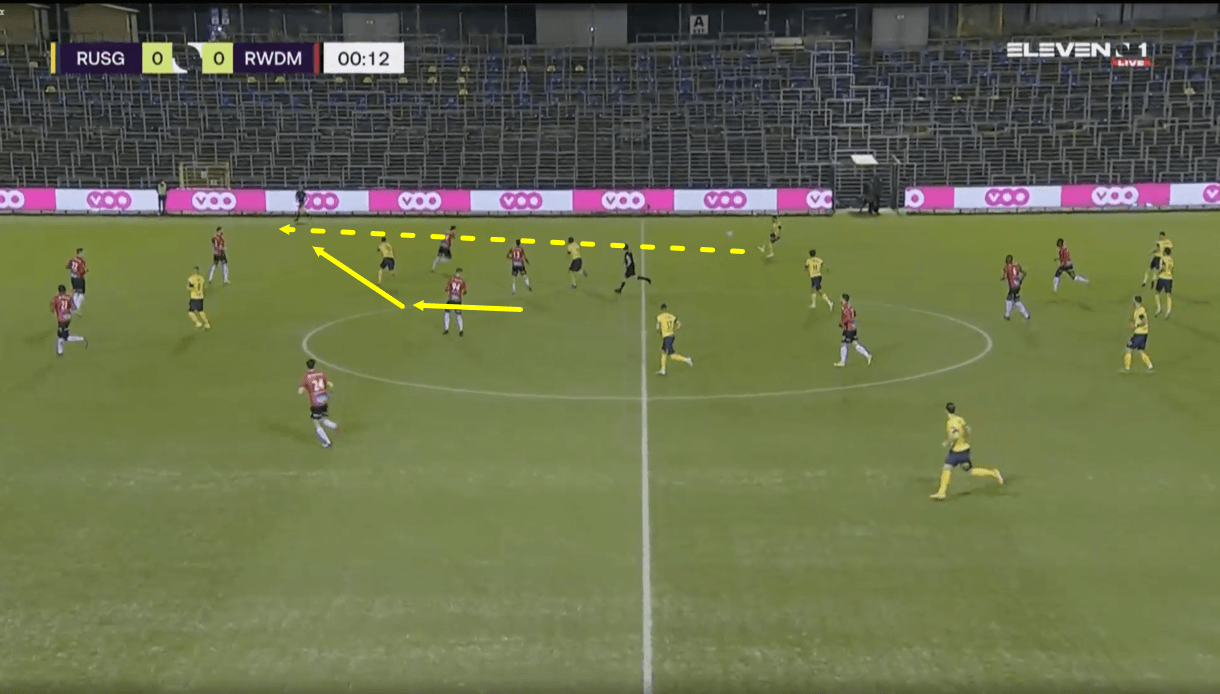
We know that Vanzeir isn’t just a goalscorer, however. As mentioned at the beginning of this tactical analysis, he managed to provide eight league assists last season, while he’s made three league assists so far in the 2021/22 campaign. One way in which the attacker creates goalscoring opportunities for teammates is also via runs in behind a relatively high backline, but instead of making his run through the centre, he often bends his run out towards the wing. We see an example of one such situation in figure 7.
Here, USG’s right wing-back has received the ball in space on the right wing, which attracts attention from the opposition’s left wing-back. As the left wing-back steps out, space is created on the wing for Vanzeir to target with his run in behind. As play moves on from here, the pacey Belgian gets onto the end of his teammates through ball and progresses along the wing, driving towards the byline and into a crossing position.
As mentioned earlier in this tactical analysis, Vanzeir isn’t much of a dribbler and doesn’t take opposition players on a lot. He is good at exploiting space with his runs, however, and his pace helps him to get onto the end of through balls into space in situations like the one seen in figure 7 where he can then drive up the wing and get into a crossing position that way.
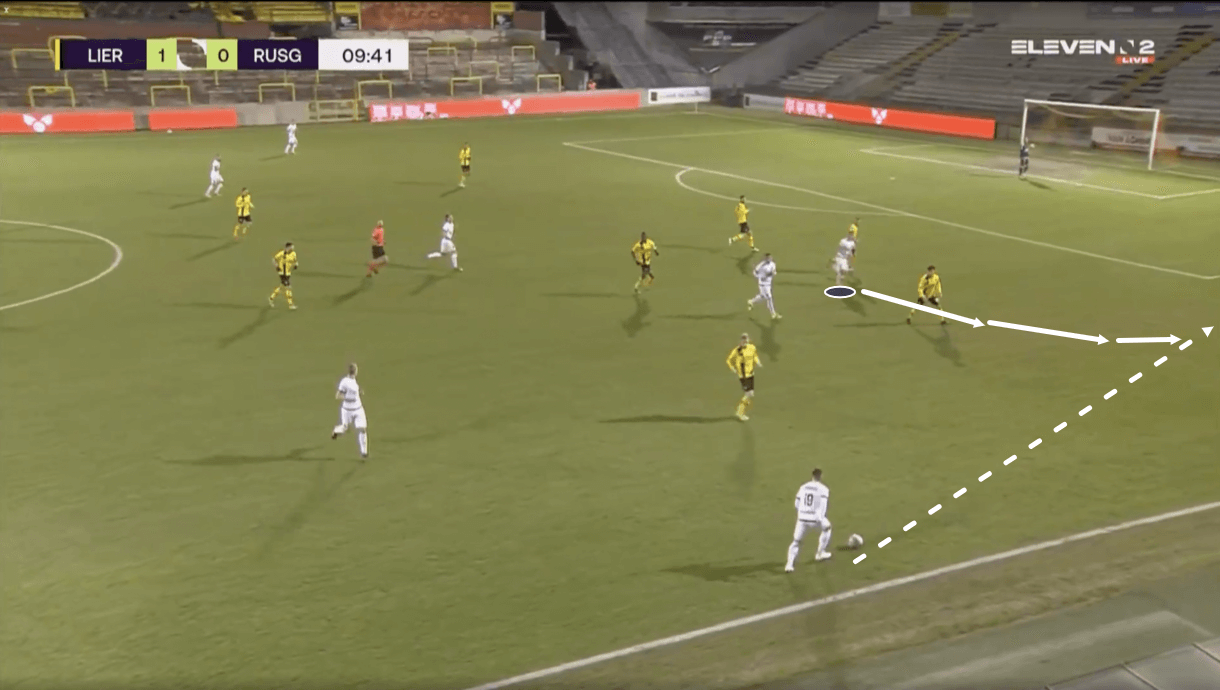
It’s very common to see Vanzeir make this outward run onto the wing from his right forward position to make himself a passing option for the wing-back. We see an example of another occasion where he pulled this off in figure 8. However, on this occasion, the opposition is playing with a back four and the left-back doesn’t defend against USG’s right wing-back as aggressively as the left wing-back did in figure 7. Despite that, Vanzeir manages to glide in behind the defender and exploit space out on the wing, simply by bending his run in such a way that he moves between the natural space between the full-back and centre-back while staying onside.
As play moves on from here, we see USG’s right wing-back drill a slightly diagonal through ball down the line and into space just on the edge of the box which Vanzeir was targeting with his run. Thanks to his intelligent movement and pace, Vanzeir is better placed to get onto the end of this through ball than anyone else and manages to do so.
This is a really effective part of the attacker’s game, particularly in terms of how it helps his playmaking ability. The Natural width in USG’s 3-5-2 is provided by the wing-backs but it’s common to see the wing-back sit just on the edge of the final third, allowing Vanzeir to exploit space out wide further up the pitch. Often, the wing-back’s deeper positioning can attract the opposition full-back/wing-back, creating even more space for Vanzeir to exploit with his run but the 23-year-old can intelligently exploit this space and provide an option for the wing-back regardless of that through his movement and the threat that his pace poses.
This movement can be particularly effective in offensive transition, as teams will often send their full-backs/wing-backs forward in attack, leaving this space open for Vanzeir.
Reactions and alertness
We can see from our analysis in the previous two sections that Vanzeir doesn’t generally do a lot on the ball before scoring. His most impressive work is generally done off the ball during the build-up and he tends to put himself in positions to score with one/two touches in the box. For all intents and purposes, Vanzeir is a good ‘poacher’, and the skill-set we’ve analysed which he frequently showcases lives up to the typical ‘goal poacher’ moniker.
Another trait frequently assigned to ‘goal poacher types is a tendency to be mentally alert and react fast to unexpected events in the final third, like the goalkeeper spilling the ball or a mistake in the backline. It’s something of an art in and of itself for an attacker to frequently demonstrate the ability to expect the unexpected and react before others.
This is another trait of Vanzeir’s which helps him to score goals. He’s good at reacting to loose balls in the box and has scored goals because of his intelligent positioning and quick reactions to events like the goalkeeper spilling the ball out in front of him during his time at USG.
It’s common for teams to concede chances because of their own mistakes. The coach’s responsibility is to limit these mistakes, while the opposition coach’s responsibility is to exploit them. Vanzeir is a useful tool that USG boss Mazzù can use to make his job easier in that sense, as he’s demonstrated a good ability to react quickly to opposition mistakes in the backline.
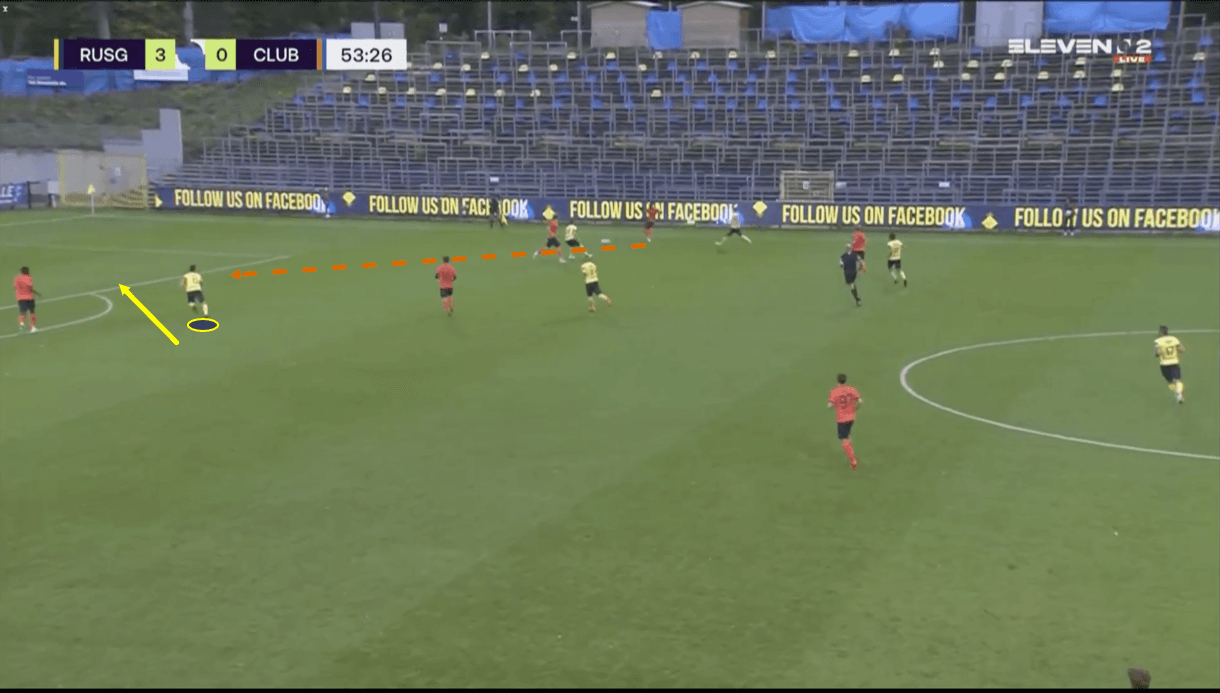
Figure 9 shows an example of one such occasion. Here, USG’s opponents are trying to build out from the back, while USG are pressing in the high-block phase. The opposition end up being pressed into the deep, wide area, which is generally the least threatening position they could be. It’s also the area where the opposition, in this case USG, are generally most likely to increase the intensity of their press, as the space to which they can play the ball into is limited by the additional defender that is the sideline.
All of this forces the opposition defender into a mistake. He opts to play the ball back to his goalkeeper, but Vanzeir anticipates the pass well and ends up intercepting and enjoying an easy goalscoring chance – the type that he doesn’t often waste. This passage of play highlights Vanzeir’s capacity to anticipate and capitalise on opposition mistakes in the backline. His reactions and general awareness of the game, in that moment, need to be high to be good at this particular skill, which they are. Vanzeir’s pace, which we’ve already touched on, along with his clinical finishing ability also don’t hurt his chances of capitalising on events like this.
Generally speaking, Vanzeir isn’t a particularly active defender – even for a forward player. He doesn’t tend to make a tonne of successful defensive actions, but he’s not inactive without the ball. While he could be more active in pressing, he demonstrates excellent awareness and reacts to opposition errors like this one well. He doesn’t fall asleep and always remains alert to events that he can react to and exploit the opposition.
Passing
Our last section of analysis will look at Vanzeir’s passing. This particular area is a mixed bag for the attacker depending on the type of pass. Vanzeir has some creative passing ability. If he didn’t, it’d have been very difficult, though not entirely impossible, for him to provide as many assists as he has during his time at USG.
However, we also know from our previous analysis that Vanzeir isn’t very active in the build-up, preferring to do most of his work off the ball during possession phases and find space in the box from where he foresees himself eventually enjoying a high-quality goalscoring opportunity.
Vanzeir’s relatively low involvement in possession phases is highlighted by the fact that, last season, he made just 18.43 passes per 90 in the league – a relatively low amount for a striker. The Belgian did make an average of 5.52 touches in the box per 90, however, which says a lot about his all-around game and the type of player he is.
In addition to making a relatively low number of passes, Vanzeir ended last season with the lowest pass accuracy (65.12%) of any centre-forward to have played at least 600 minutes in Belgium’s second-tier last term. This isn’t because of a tendency to mainly try low-percentage but potentially creative passes, however. Vanzeir’s forward passing accuracy (61.97%) was fairly average for a striker. It was actually his low backwards passing accuracy (82.42%) and lateral passing accuracy (63.71%) that made the biggest impact on his overall poor pass accuracy rate, as he ranked very poorly among Belgian First Division B forwards in these areas.
While he loves to exploit space behind the opposition backline, Vanzeir isn’t particularly comfortable with receiving the ball to feet with his back to goal. This may be one key reason as to why he’s not generally very involved in possession phases other than finishing them off.
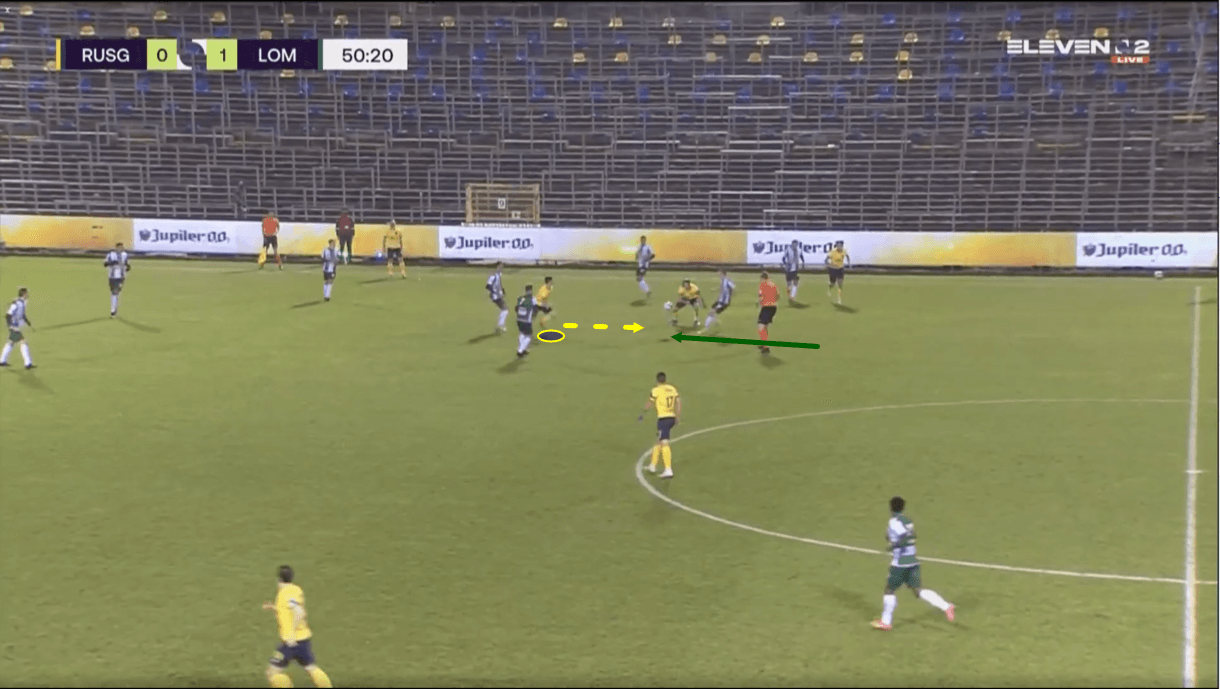
In figure 10, for example, Vanzeir opted to drop deeper than normal to provide an option for a teammate, but his backwards pass was misdirected and ultimately resulted in a turnover in the middle third of the pitch, allowing the opposition to spring a counter-attack.
Vanzeir’s passing isn’t always the crispest, while he’s also not always comfortable receiving with his back to goal and quickly linking up with teammates during possession phases. When receiving with his back to goal with no space to turn and run at the defence, he tends to take a few touches before releasing. He takes too much out of the ball at times and doesn’t seem to be extremely comfortable in tight spaces with his back to goal, so this is a potential area of improvement for the young attacker to work on.
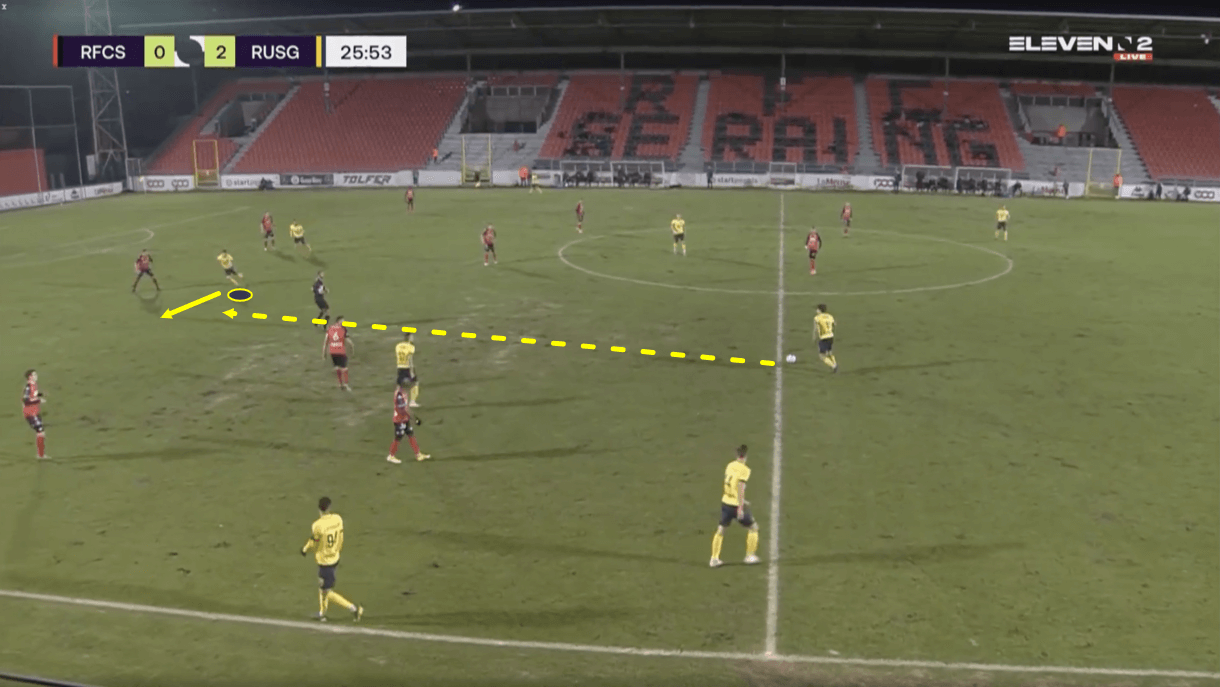
If at all possible, Vanzeir will try to receive the ball in such a way that he can turn and run at the opposition backline. Figures 11 and 12 provide an example of this. Firstly, in figure 11, we see Vanzeir receiving the ball in the left forward position.
Often, if a forward were receiving this type of pass, you might see him look to exploit the space in between the lines or back into the defender to hold up the play before linking up with a teammate advancing from deep. However, Vanzeir doesn’t have the size or strength to back into big defenders, nor does he seemingly like to drop into the central spaces. He much prefers, like we saw in the second section, to move into wider spaces and run at the defence, rather than play with his back to goal.
As a result, we see the forward turning his body and running towards the wing just before this pass is played, making it clear to the passer that he wants the ball to be played to his side, with the aim of moving out onto the wing.
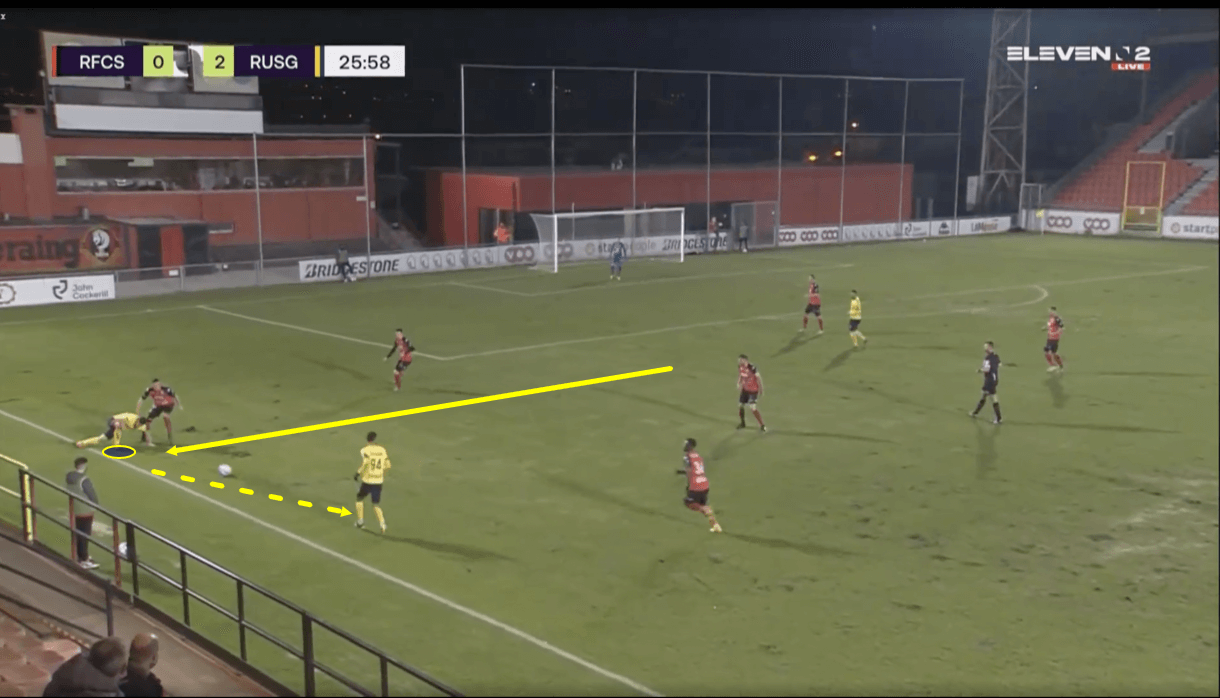
As this passage of play moves on into figure 12, we see that this particular attempt to move out onto the wing and drive at the defence was unsuccessful. The space never really opened up for Vanzeir to fully turn and drive at the defence from the wing, while he remained under constant pressure while dribbling with the ball. After taking a few touches, the Belgian ended up in the position we see him in figure 12, and ultimately ended up having to pass to the left wing-back under pressure.
So, we can see that even in these situations when receiving a pass fairly centrally with the opportunity to exploit central space, Vanzeir really prefers to drive at the defence and prefers wider areas to central ones too. Ultimately, he probably isn’t the best option to play with his back to goal. Although this may be an area for the attacker to work on, this probably isn’t a major issue so much as it’s a stylistic preference worth noting until he improves in this area, but he’s clearly very comfortable in other situations which his team has successfully played to throughout his time at USG.
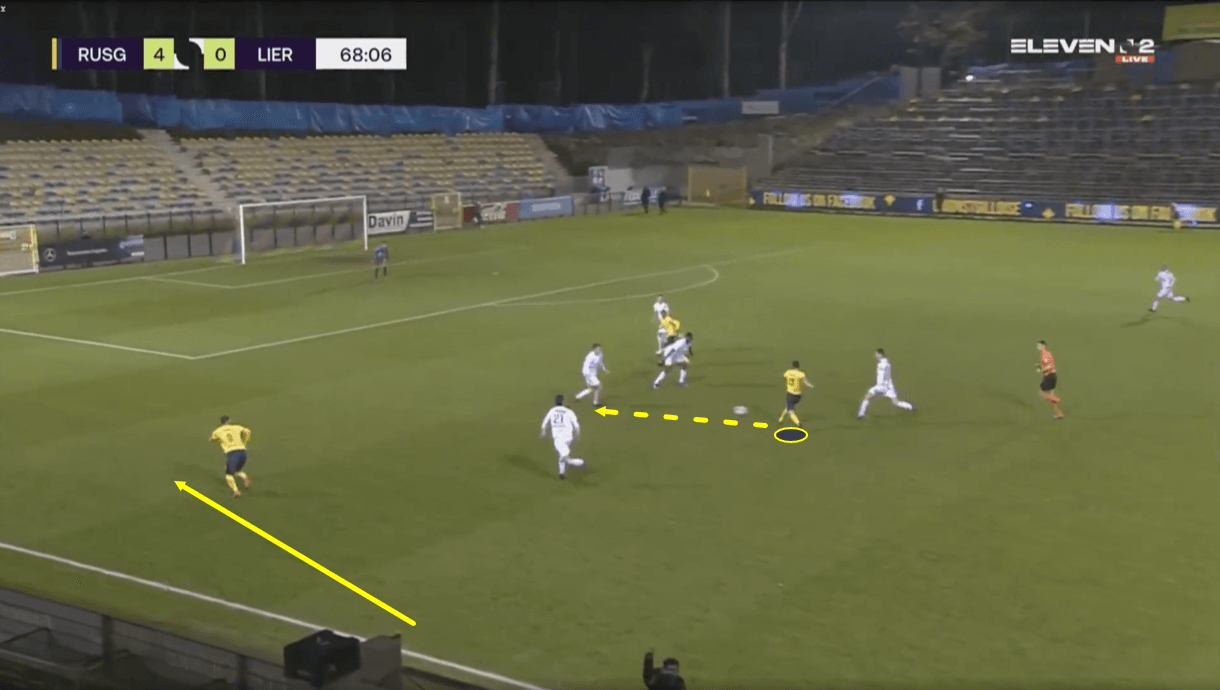
Lastly, in terms of creative passing, again, Vanzeir hasn’t been incredible in tighter areas. For example, we see Vanzeir on the ball with runners ahead of him, but also in front of several opposition defenders, in figure 13. While it’s possible to thread the ball through two of the defenders in front of him and into his left-wing teammate’s path here, the attacker ultimately fails to beat the defender in front of him.
This is, of course, a difficult pass to make and why players who can thread balls through tight spaces are so highly rated and valued. However, Vanzeir isn’t incredible when placed in the position of playmaker in this type of situation. It plays to his strengths and preferences much more for him to be the runner in situations like this, which he generally is, but occasionally, the chips have fallen in such a way that he naturally ends up in this position, which isn’t optimal. As this particular passage of play moves on, the opposition enjoy a chance to spring a counter-attack and at the very least end this USG attack at the last moment before they would’ve been through on goal, so it was a valuable interception and a key moment where a more threatening passer being on the ball might’ve made a big difference.
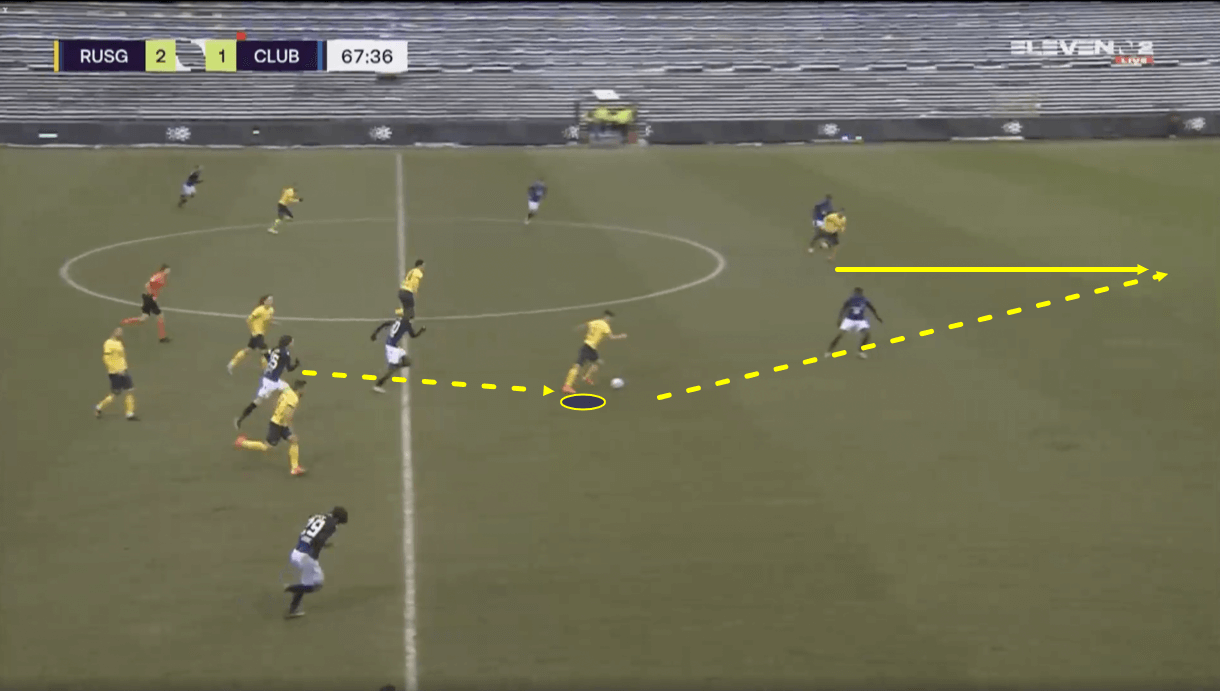
However, Vanzeir can be a very valuable player in a very similar type of situation in offensive transitions – again, perhaps highlighting why he’s arguably best-suited to a counter-attacking system. Figure 14 shows an example of how Vanzeir has proven to be a valuable playmaker in offensive transitions during his time at USG.
Just before this image, USG regained possession via an interception in central midfield, in the middle third of the pitch. The midfielder who won the ball immediately got his head up and, coming under pressure from the opposition, passed the ball forward to Vanzeir, who was in space in the right forward position.
This left the attacker in a very similar situation to the one we saw in figure 13, but with one major difference – this time, the opposition were just beginning to transition to defence, and there’s less defensive bodies in front of the USG man to guard against the dangerous through ball. This time, Vanzeir didn’t have to be as accurate with his pass and as play moves on, we see him successfully evade the defender with his pass and send his strike partner through on goal.
These images highlight that Vanzeir can operate effectively when required to play that final ball versus a less compact, more disorganised defence in transition, but struggles against a more organised defence with less space to penetrate.
Conclusion
To conclude this tactical analysis and scout report, we feel that Vanzeir is a really exciting budding star of Belgium’s top-flight. His intelligent movement, good shooting technique/efficient finishing, speed, alertness and quick reactions are some of his greatest strengths that all combine to create a really efficient poacher. USG’s effective utilisation of these key strengths is why Vanzeir has thrived since his move to Stade Joseph Marien.
Vanzeir’s passing and dribbling, particularly in tight spaces, could be viewed as potential areas of improvement in his game, but in the right role, he has proven capable of thriving despite these limitations.

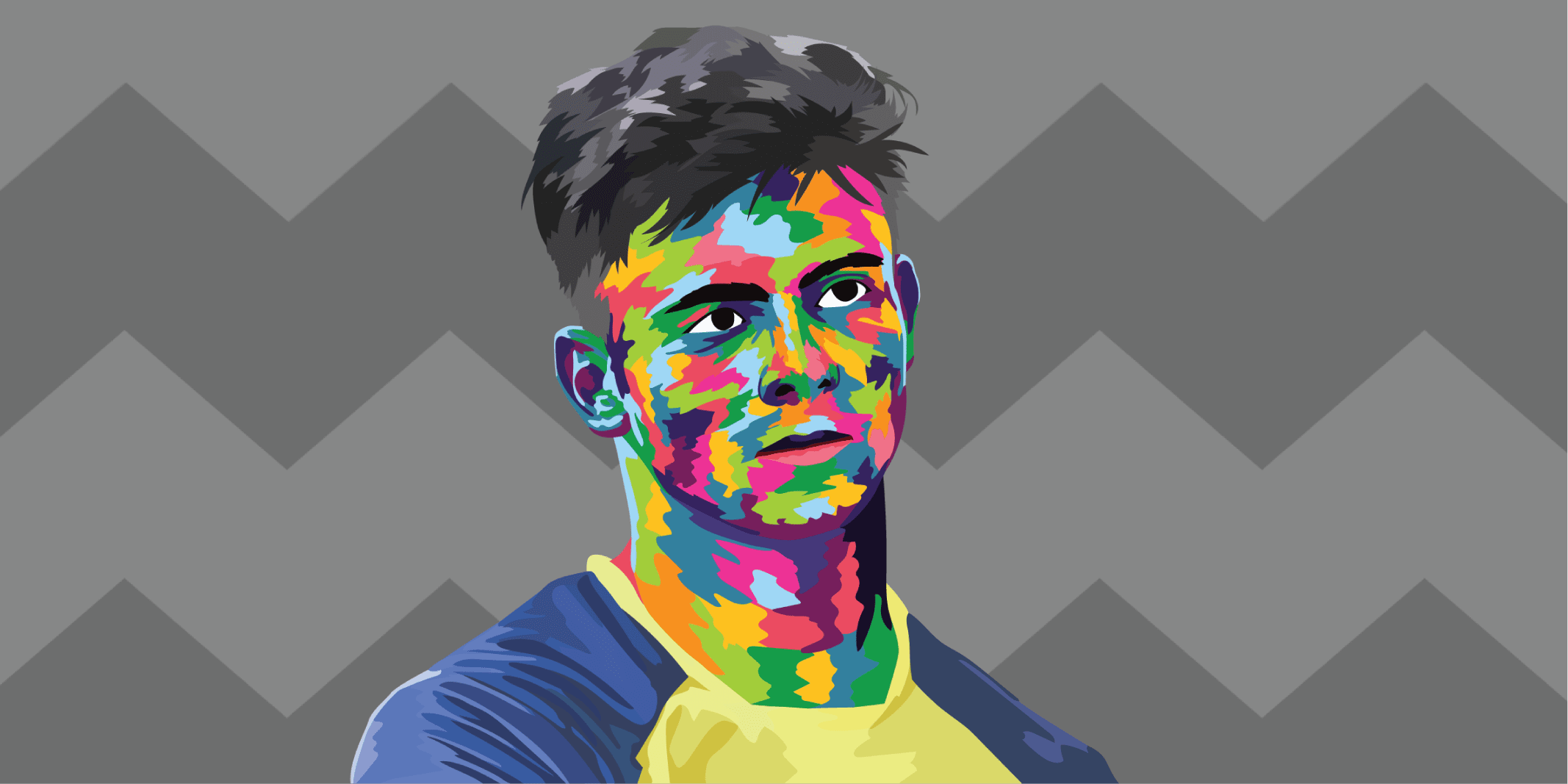



Comments